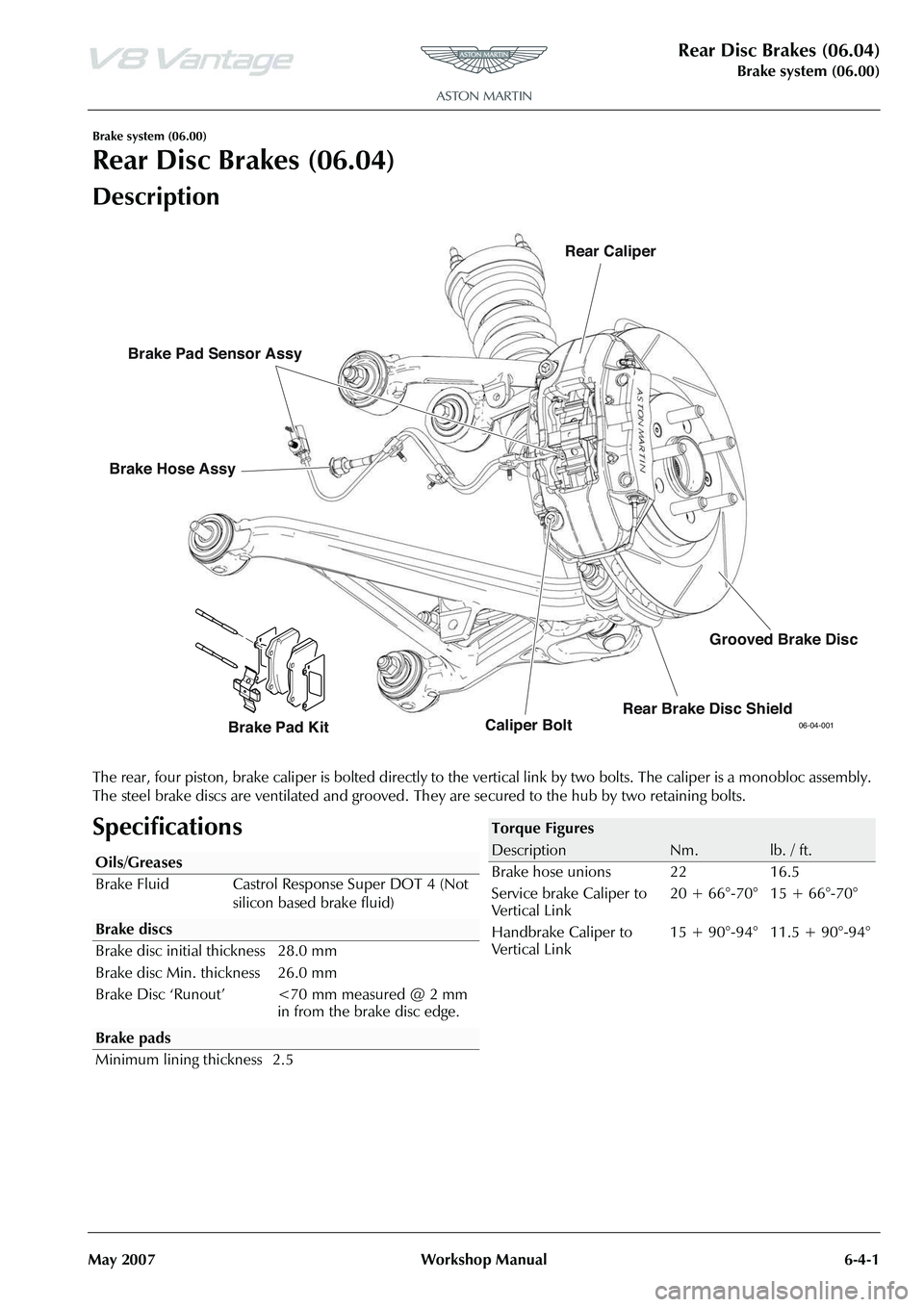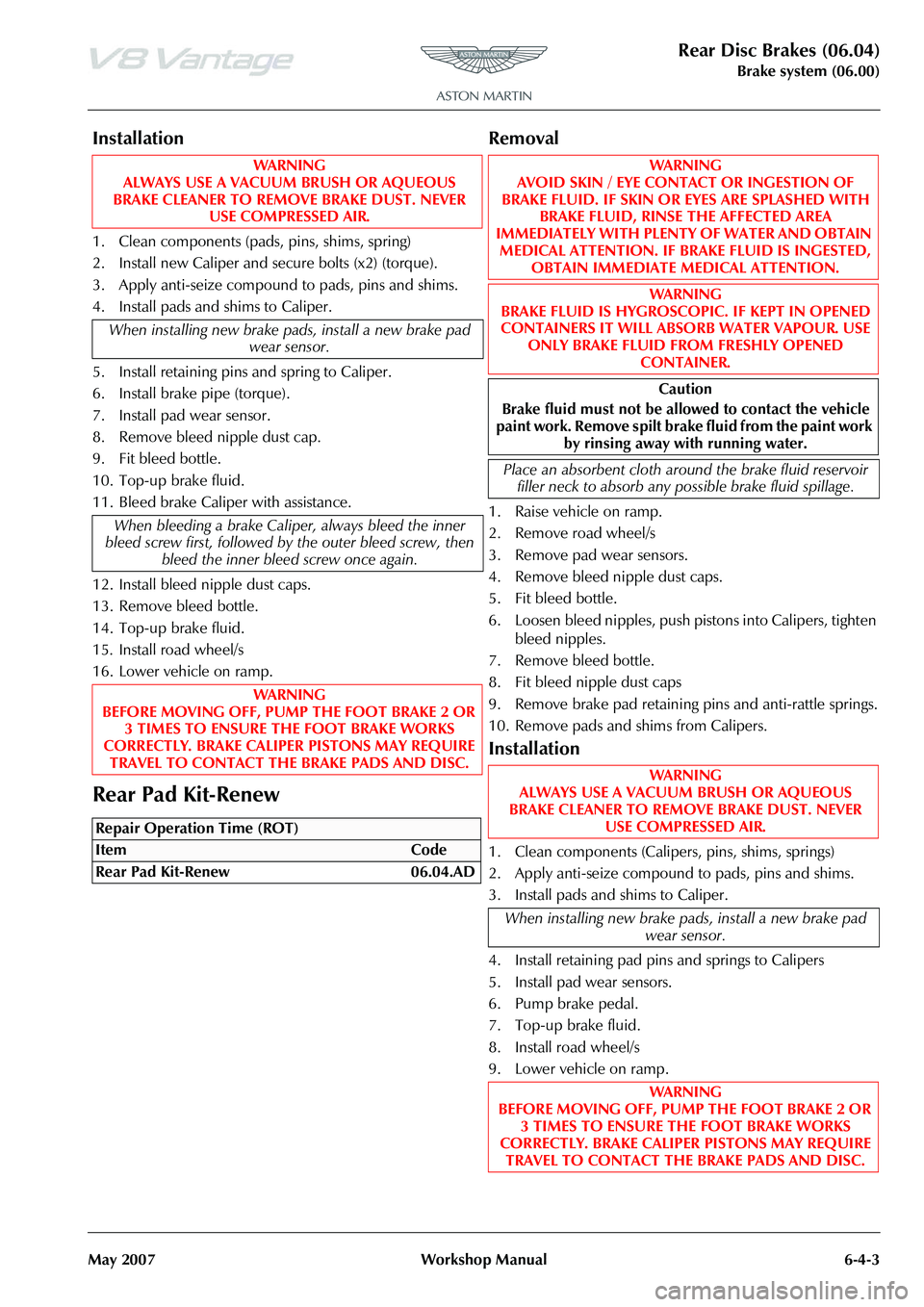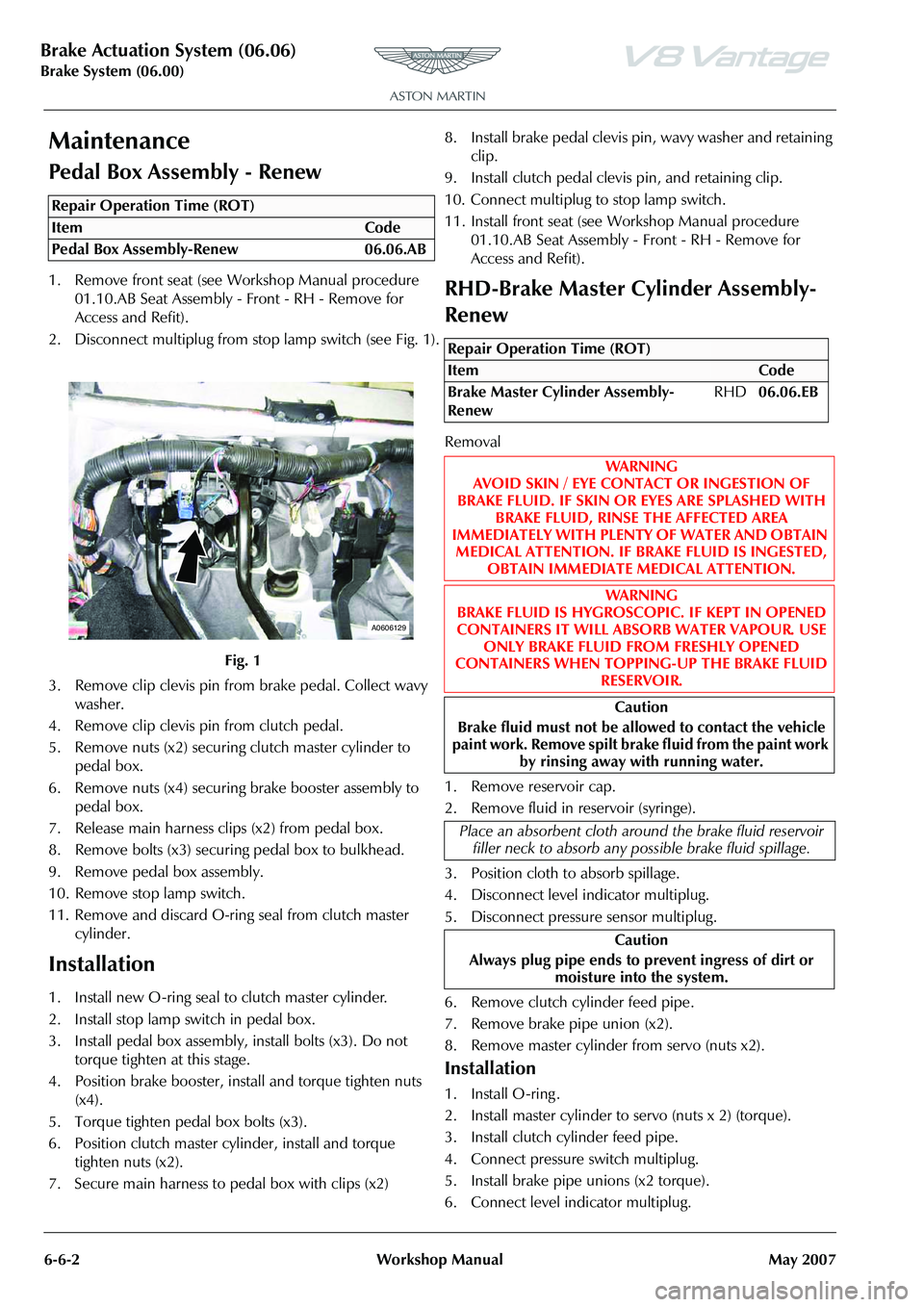torque ASTON MARTIN V8 VANTAGE 2010 Workshop Manual
[x] Cancel search | Manufacturer: ASTON MARTIN, Model Year: 2010, Model line: V8 VANTAGE, Model: ASTON MARTIN V8 VANTAGE 2010Pages: 947, PDF Size: 43.21 MB
Page 479 of 947

Rear Disc Brakes (06.04)
Brake system (06.00)
May 2007 Workshop Manual 6-4-1
Brake system (06.00)
Rear Disc Brakes (06.04)
Description
The rear, four piston, brake caliper is bolted directly to the ve rtical link by two bolts. The caliper is a monobloc assembly.
The steel brake discs are ventilated and grooved. Th ey are secured to the hub by two retaining bolts.
Specifications
06-04-001Caliper BoltRear Caliper
Brake Hose Assy
Brake Pad Kit
Brake Pad Sensor Assy
Rear Brake Disc ShieldGrooved Brake Disc
Oils/Greases
Brake Fluid Castrol Response Super DOT 4 (Not
silicon based brake fluid)
Brake pads
Minimum lining thickness 2.5
Torque Figures
DescriptionNm.lb. / ft.
Brake hose unions 22 16.5
Service brake Caliper to
Vertical Link 20 + 66°-70° 15 + 66°-70°
Handbrake Caliper to
Vertical Link 15 + 90°-94° 11.5 + 90°-94°
Page 481 of 947

Rear Disc Brakes (06.04)
Brake system (06.00)
May 2007 Workshop Manual 6-4-3
Installation
1. Clean components (pads, pins, shims, spring)
2. Install new Caliper and secure bolts (x2) (torque).
3. Apply anti-seize compound to pads, pins and shims.
4. Install pads and shims to Caliper.
5. Install retaining pins and spring to Caliper.
6. Install brake pipe (torque).
7. Install pad wear sensor.
8. Remove bleed nipple dust cap.
9. Fit bleed bottle.
10. Top-up brake fluid.
11. Bleed brake Calipe r with assistance.
12. Install bleed nipple dust caps.
13. Remove bleed bottle.
14. Top-up brake fluid.
15. Install road wheel/s
16. Lower vehicle on ramp.
Rear Pad Kit-Renew
Removal
1. Raise vehicle on ramp.
2. Remove road wheel/s
3. Remove pad wear sensors.
4. Remove bleed nipple dust caps.
5. Fit bleed bottle.
6. Loosen bleed nipples, push pistons into Calipers, tighten bleed nipples.
7. Remove bleed bottle.
8. Fit bleed nipple dust caps
9. Remove brake pad retaining pins and anti-rattle springs.
10. Remove pads and shims from Calipers.
Installation
1. Clean components (Caliper s, pins, shims, springs)
2. Apply anti-seize compound to pads, pins and shims.
3. Install pads and shims to Caliper.
4. Install retaining pad pins and springs to Calipers
5. Install pad wear sensors.
6. Pump brake pedal.
7. Top-up brake fluid.
8. Install road wheel/s
9. Lower vehicle on ramp.
WA R N I N G
ALWAYS USE A VACUUM BRUSH OR AQUEOUS
BRAKE CLEANER TO REMOVE BRAKE DUST. NEVER USE COMPRESSED AIR.
When installing new brake pads, install a new brake pad wear sensor.
When bleeding a brake Calipe r, always bleed the inner
bleed screw first, followed by the outer bleed screw, then
bleed the inner bleed screw once again.
WA R N I N G
BEFORE MOVING OFF, PUMP THE FOOT BRAKE 2 OR 3 TIMES TO ENSURE THE FOOT BRAKE WORKS
CORRECTLY. BRAKE CALIPER PISTONS MAY REQUIRE TRAVEL TO CONTACT THE BRAKE PADS AND DISC.
Repair Operation Time (ROT)
WA R N I N G
AVOID SKIN / EYE CONTACT OR INGESTION OF
BRAKE FLUID. IF SKIN OR EYES ARE SPLASHED WITH BRAKE FLUID, RINSE THE AFFECTED AREA
IMMEDIATELY WITH PLENTY OF WATER AND OBTAIN
MEDICAL ATTENTION. IF BRAKE FLUID IS INGESTED, OBTAIN IMMEDIATE MEDICAL ATTENTION.
WA R N I N G
BRAKE FLUID IS HYGROSCOPI C. IF KEPT IN OPENED
CONTAINERS IT WILL ABSORB WATER VAPOUR. USE ONLY BRAKE FLUID FROM FRESHLY OPENED
CONTAINER.
Caution
Brake fluid must not be allo wed to contact the vehicle
paint work. Remove spilt brake fluid from the paint work by rinsing away with running water.
Place an absorbent cloth arou nd the brake fluid reservoir
filler neck to absorb any po ssible brake fluid spillage.
WA R N I N G
ALWAYS USE A VACUUM BRUSH OR AQUEOUS
BRAKE CLEANER TO REMOVE BRAKE DUST. NEVER USE COMPRESSED AIR.
When installing new brake pa ds, install a new brake pad
wear sensor.
WA R N I N G
BEFORE MOVING OFF, PUMP THE FOOT BRAKE 2 OR 3 TIMES TO ENSURE THE FOOT BRAKE WORKS
CORRECTLY. BRAKE CALIPER PISTONS MAY REQUIRE
TRAVEL TO CONTACT THE BRAKE PADS AND DISC.
Page 482 of 947

Rear Disc Brakes (06.04)
Brake system (06.00)6-4-4 Workshop Manual May 2007
Rear Brake Hose Assembly-Renew
Removal
1. Raise vehicle on ramp.
2. Remove road wheel/s
3. Remove bleed nipple dust caps.
4. Fit bleed bottle to RHR/LHR Caliper, open bleed nipples (x1).
5. Fit bleed bottle to RHF/LHF Caliper, open bleed nipples (x1).
6. Depress brake pedal >60 mm and secure with support.
7. Tighten RHF/LHR bleed nipple, remove bleed bottle and fit dust cap.
8. Tighten RHR/LHR bleed nipple, remove bleed bottle.
9. Remove clips (x3) wear indicator harness to brake hose.
10. Remove brake hose from Ca liper (cap and plug open
orifices).
11. Remove brake union from hose.
12. Remove hose C-clip and remove hose.
Installation
1. Install hose C-clip and hose.
2. Install brake union to hose (torque).
3. Install brake pipe to Cali per (torque) using alignment
tool (206-100).
4. Remove pedal support.
5. Top-up brake fluid.
6. Bleed brake Caliper with assistance. 7. Remove bleed bottle.
8. Fit bleed nipple dust caps.
9. Clean off excess fluid.
10. Top-up brake fluid.
11. Install road wheel/s
12. Lower vehicle on ramp.
Repair Operation Time (ROT)
Page 483 of 947

Hand Brake (06.05)
Brake Systems (06.00)
May 2007 Workshop Manual 6-5-1
Brake Systems (06.00)
Hand Brake (06.05)
Description
The handbrake control lever is located on the outside of the drivers seat and brakes the rear road wheels through a cable
system and two mechanical handbrake Calipers. Handbrake pads are applied by the mechanical brake Calipers (x2), one
acting on each rear road wheel brake disc. The Calipers are bo lted to the vertical links. Return springs on each Caliper
retract the pads when the parking brake is released.
Wear in the parking brake pads is compensated for automati cally by a mechanism within the calipers. Cable stretch is
compensated by cable adjusters.
A handbrake switch is wired normally closed. The switch is he ld open whilst the handbrake is ‘off’ and closes when the
handbrake is applied. The handbrake warning lamp on the instrument panel is illuminated when the handbrake is applied.
Specifications
06-05-001
Unlock
Button
Handbrake
Lever
Trunnion
Handbrake Cable
Stop Assembly
Handbrake Caliper
& Pad Assy
Brake pads
Minimum lining thickness 2mm
Torque Figures
DescriptionNm.lb. / ft.
Brake Caliper to Vertical Link 15 + 92° 11.5 + 92°
Page 487 of 947

Brake Actuation System (06.06)
Brake System (06.00)
May 2007 Workshop Manual 6-6-1
Brake System (06.00)
Brake Actuation System (06.06)
Description
Tandem Master Cylinder
The short-stroke tandem master-cylinder controls two
separate brake circuits which are jointly activated by the
brake pedal. In the event of a major leak in one system, the
other will still function. The two systems are supplied by a
common brake fluid reservoir.
A pressure sensor attached to the master-cylinder provides
the ABS / DSC module with brake pressure information. This
information informs the system how hard the driver is
braking and is used as an aid for the ABS / DSC to achieve
accurate brake pressure control.
Brake Fluid Reservoir
The brake fluid reservoir is mo unted directly on the tandem
master cylinder and secured with a pin. Two stub pipes, on
the base of the reservoir, locate into the primary and
secondary chambers of the tandem master cylinder.
An integral fluid-level switch is incorporated in the reservoir.
If the brake fluid level is low, the brake warning lamp in the
Driver Information Module (D IM) will illuminate and ‘LOW
BRAKE FLUID’ will be displayed in the message center right.
Specifications
Oils/Greases
Brake Fluid Castrol Response Super Dot 4
Torque Figures
DescriptionNm.
Master Cylinder Mount 25 (+/- 4)
Brake Pipe Unions 17
Brake fluid reservoir securing pin 4
Pressure Sensor 35 (+/- 2)
Page 488 of 947

Brake Actuation System (06.06)
Brake System (06.00)
6-6-2 Workshop Manual May 2007
Maintenance
Pedal Box Assembly - Renew
1. Remove front seat (see Workshop Manual procedure 01.10.AB Seat Assembly - Front - RH - Remove for
Access and Refit).
2. Disconnect multiplug from stop lamp switch (see Fig. 1).
3. Remove clip clevis pin from brake pedal. Collect wavy washer.
4. Remove clip clevis pin from clutch pedal.
5. Remove nuts (x2) securing clutch master cylinder to
pedal box.
6. Remove nuts (x4) securing brake booster assembly to
pedal box.
7. Release main harness clips (x2) from pedal box.
8. Remove bolts (x3) securing pedal box to bulkhead.
9. Remove pedal box assembly.
10. Remove stop lamp switch.
11. Remove and discard O-ring seal from clutch master cylinder.
Installation
1. Install new O-ring seal to clutch master cylinder.
2. Install stop lamp switch in pedal box.
3. Install pedal box assembly, install bolts (x3). Do not torque tighten at this stage.
4. Position brake booster, install and torque tighten nuts (x4).
5. Torque tighten pedal box bolts (x3).
6. Position clutch master cy linder, install and torque
tighten nuts (x2).
7. Secure main harness to pedal box with clips (x2) 8. Install brake pedal clevis pin, wavy washer and retaining
clip.
9. Install clutch pedal clevis pin, and retaining clip.
10. Connect multiplug to stop lamp switch.
11. Install front seat (see Workshop Manual procedure
01.10.AB Seat Assembly - Front - RH - Remove for
Access and Refit).
RHD-Brake Master Cylinder Assembly-
Renew
Removal
1. Remove reservoir cap.
2. Remove fluid in reservoir (syringe).
3. Position cloth to absorb spillage.
4. Disconnect level indicator multiplug.
5. Disconnect pressure sensor multiplug.
6. Remove clutch cylinder feed pipe.
7. Remove brake pipe union (x2).
8. Remove master cylinder from servo (nuts x2).
Installation
1. Install O-ring .
2. Install master cylinder to servo (nuts x 2) (torque).
3. Install clutch cylinder feed pipe.
4. Connect pressure switch multiplug.
5. Install brake pipe unions (x2 torque).
6. Connect level indicator multiplug.
Repair Operation Time (ROT)
A0606129
Repair Operation Time (ROT)
ItemCode
Brake Master Cylinder Assembly-
Renew RHD
06.06.EB
WAR NI NG
AVOID SKIN / EYE CONTACT OR INGESTION OF
BRAKE FLUID. IF SKIN OR EYES ARE SPLASHED WITH BRAKE FLUID, RINSE THE AFFECTED AREA
IMMEDIATELY WITH PLENTY OF WATER AND OBTAIN MEDICAL ATTENTION. IF BR AKE FLUID IS INGESTED,
OBTAIN IMMEDIATE MEDICAL ATTENTION.
WAR NI NG
BRAKE FLUID IS HYGROSCOPIC. IF KEPT IN OPENED
CONTAINERS IT WILL ABSORB WATER VAPOUR. USE ONLY BRAKE FLUID FROM FRESHLY OPENED
CONTAINERS WHEN TOPPING-UP THE BRAKE FLUID
RESERVOIR.
Caution
Brake fluid must not be allowed to contact the vehicle
paint work. Remove spilt brake fluid from the paint work
by rinsing away with running water.
Place an absorbent cloth around the brake fluid reservoir filler neck to absorb any possible brake fluid spillage.
Caution
Always plug pipe ends to prevent ingress of dirt or
moisture into the system.
Page 489 of 947

Brake Actuation System (06.06)
Brake System (06.00)
May 2007 Workshop Manual 6-6-3
7. Fill reservoir.
8. Bleed Brakes (see Workshop Manual procedure 06.06.AD Pad Kit - Manual Brake and Clutch Pedal -
Renew).
LHD-Brake Master Cylinder Assembly-
Renew
Removal
1. Remove corner cross brace.
2. Move expansion tank aside for access (bolt x1, nut x1, hose clips x2, multiplug x1).
3. Disconnect clutch reservoir feed pipe.
4. Disconnect multiplugs (x2).
5. Disconnect brake pipes from master cylinder (move aside).
6. Remove reservoir holding screw for access to master cylinder retaining nut.
7. Remove master cylinder from booster (nuts x2).
Installation
1. On new master cylinder - Remove reservoir holding screw for access to master cylinder retaining nut.
2. Install master cylinder to booster (nuts x2).
3. Install reservoir holding screw for access to master cylinder retaining nut.
4. Connect brake pipes to master cylinder.
5. Connect clutch reservoir feed pipe. 6. Connect multiplugs (x2).
7. Install expansion tank aside (bolt x1, nut x1, hose clips
x2, multiplug x1).
8. Install corner cross brace (torque) (only fully tighten
when vehicle on level floor).
9. Bleed Brakes (see Workshop Manual procedure 06.06.AD Pad Kit - Manual Brake and Clutch Pedal -
Renew).
10. Top-up coolant.
Clutch Master Cylinder Assembly-Renew
Removal
1. Move drivers seat fully rearward.
2. Remove clevis pin and clip.
3. Remove cylinder securing nuts (x2).
4. Remove fluid (syringe) from brake master cylinder to
below clutch level.
5. Remove corner cross brace.
6. Move expansion tank aside for access (bolt x1, nut x1, hose clips x2, multiplug x1).
7. Disconnect clutch reservoir feed pipe.
8. Disconnect clutch pipe quick fit (pull clip back) and move aside.
9. Remove cylinder assembly.
10. Remove and discard O-ring seal from master cylinder.
11. Split components
12. Remove pipe from cy linder (mark position).
Repair Operation Time (ROT)
Repair Operation Time (ROT)
Page 490 of 947

Brake Actuation System (06.06)
Brake System (06.00)
6-6-4 Workshop Manual May 2007
13. Re-fit components
14. Install pipe to cylinder.
Installation
1. Install new O-ring seal on master cylinder.
2. Install cylinder assembly.
3. Connect pipe to master cylinder (quickfit).
4. Connect clutch reservoir feed pipe.
5. Install expansion tank aside (bolt x1, nut x1, hose clips x2, multiplug x1).
6. Install corner cross brace (torque) (only fully tighten when vehicle on level floor).
7. Install cylinder retaining nuts (x2) (torque).
8. Install clevis pin and clip.
9. Bleed clutch system (see Workshop Manual procedure 08.00.AF - Clutch Hydraulic System - Bleed).
10. Top-up coolant.
RH/LH Front Caliper Hose Assembly-
Renew
Removal
1. Raise vehicle on ramp.
2. Remove road wheel(s).
3. Remove RH/LH front wheel arch liner (see Workshop
Manual procedure 01.02.FB/01.02.GB Wheel Arch
Liner - Front - RH/LH - Renew).
4. Remove bleed nipple dust caps.
5. Position bleed container, connect bleed hose to RHR/ LHR Caliper, open bleed nipples (x1).
6. Position bleed container, connect bleed hose to RHF/ LHF Caliper, open bleed nipples (x1).
7. Depress brake pedal >60 mm and secure with support. 8. Tighten RHR/LHR bleed nipple, disconnect bleed hose,
remove bleed container and fit dust cap.
9. Tighten RHF/LHF bleed nipple, disconnect bleed hose, remove bleed container and fit dust cap.
10. Loosen and disconnect RH/LH front brake tube union from in line connector (see Fig. 1 - RHS shown).
11. Loosen and disconnect RH/LH front brake tube union from hose connection.
12. Release brake tube from clips (x2), remove brake tube.
Installation
1. Install brake tube, connect unions, secure brake tube in clips (x2), torque tighten unions.
2. Install RH/LH front wheel arch liner (see Workshop Manual procedure 01.02.FB/01.02.GB Wheel Arch
Liner - Front - RH/LH - Renew).
3. Remove pedal support.
4. Top-up brake fluid.
5. Bleed brake Caliper with assistance.
6. Remove bleed bottle.
7. Install bleed nipple dust caps.
8. Clean off excess fluid.
9. Top-up brake fluid.
10. Install road wheel(s)).
11. Lower vehicle on ramp.
Repair Operation Time (ROT)
Caution
Always plug pipe ends to prevent ingress of dirt or
moisture into the system.
Fig. 1
A0606125
Page 491 of 947

Brake Actuation System (06.06)
Brake System (06.00)
May 2007 Workshop Manual 6-6-5
RH/LH Rear Brake Caliper Tube
Assembly-Renew
Removal
1. Raise vehicle on ramp.
2. Remove road wheel(s).
3. Remove bleed nipple dust caps.
4. Fit bleed bottle to RHR/LHR Caliper, open bleed nipples (x1).
5. Fit bleed bottle to RHF/LHF Caliper, open bleed nipples (x1).
6. Depress brake pedal >60 mm and secure with support.
7. Tighten RHF bleed nipple, remove bleed bottle and fit dust cap.
8. Tighten RHR/LHR bleed nipple, remove bleed bottle.
9. Remove screws (x5) securi ng LH/RH rear wheel arch
liner to body. 10. Ease wheel arch liner downwards to access brake tube
union (see Fig. 1 - RHS shown).
11. Loosen and disconnect brake tube unions from LH/RH in line connection and RH brake hose connection (see
Fig. 2- LHS shown).
12. Release brake tube from clips (x5) on subframe.
13. Manoeuvre and remove brake tube.
Installation
1. Install brake tube, connect unions (x2), secure brake tube in clips (x5). Torque tighten unions.
2. Position wheel arch liner, in stall and tighten screws (x5).
3. Remove pedal support.
4. Top-up brake fluid.
5. Bleed brake Caliper with assistance.
Repair Operation Time (ROT)
Fig. 1
Caution
Always plug pipe ends to prevent ingress of dirt or moisture into the system.
Fig. 2
Caution
Brake fluid must not be allo wed to contact the vehicle
paint work. Remove spilt brake fluid from the paint work by rinsing away with running water.
A0606122
A0606123
Page 492 of 947

Brake Actuation System (06.06)
Brake System (06.00)
6-6-6 Workshop Manual May 2007
6. Remove bleed bottle.
7. Fit bleed nipple dust caps.
8. Clean off excess fluid.
9. Top-up brake fluid.
10. Install road wheel/s
11. Lower vehicle on ramp.
Brake Master Cylinder to Modulator
Secondary Tube Assembly-Renew
Removal
1. Raise vehicle on ramp.
2. Remove road wheel(s).
3. Remove LH front wheel arch liner (see Workshop Manual procedure 01.02.FB/01.02.BC Wheel Arch
Liner - Front - LH - Renew).
4. Remove bleed nipple dust caps.
5. Position bleed container, connect bleed hose to LHR Caliper, open bleed nipples (x1).
6. Position bleed container, connect bleed hose to LHF Caliper, open bleed nipples (x1).
7. Depress brake pedal >60 mm and secure with support.
8. Tighten LHR bleed nipple, disconnect bleed hose, remove bleed container and fit dust cap.
9. Tighten LHF bleed nipple, disconnect bleed hose, remove bleed container and fit dust cap. 10. Loosen and disconnect brake tube union from
modulator (see Fig. 1).
11. Loosen and disconnect brak e tube union from master
cylinder.
12. Remove brake tube.
Installation
1. Install brake tube, connect and torque tighten unions.
2. Install LH front wheel arch liner (see Workshop Manual procedure 01.02.FB/01.02.BC Wheel Arch Liner - Front
- LH - Renew).
3. Remove pedal support.
4. Top-up brake fluid.
5. Brake bleed (see Workshop Manual procedure 06.07.DD Brake Hydraulic System - Flush/Refill/Bleed).
6. Install road wheel(s)).
7. Lower vehicle on ramp.
Repair Operation Time (ROT)
Fig. 1
A0606126